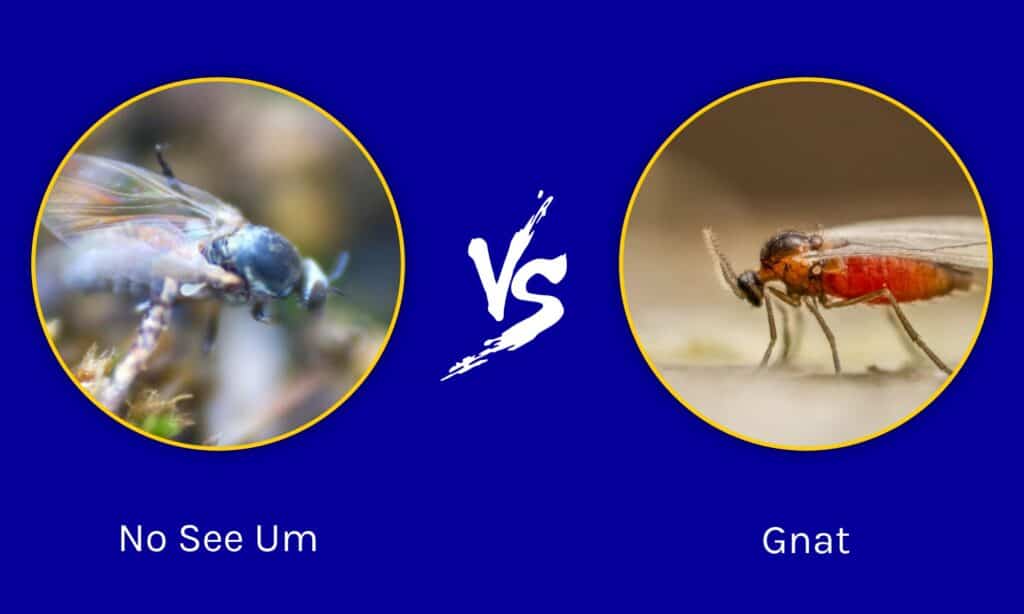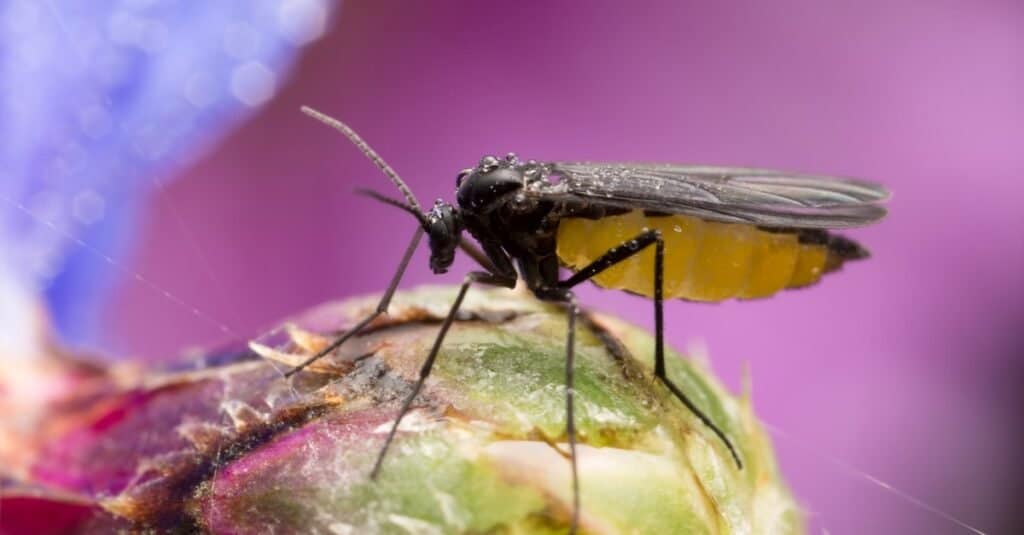Have you ever wondered just what that small flying insect is that’s buzzing around your face? One of the most annoying things is getting bitten by an insect but not knowing exactly what it is that’s bitten you – especially when some insects have much more painful bites than you might expect given their size. Some of these small biting insects are no-see-ums which are often known as biting midges, while others that are extremely common are called gnats.
Both are found virtually all around the world in many different habitats, particularly around slow-moving water, but just what are the differences between the two? Join us as we discover everything you need to know about no-see-ums vs. gnats!

Comparing Gnats vs. No-See-Ums
Gnat is a loose descriptive term rather than a scientific one and is used to describe a group of tiny flies. Gnats are generally described as being any species in the Nematocera suborder. No-see-ums are tiny flies from the family group Ceratopogonidae of which there are around 5,000 species worldwide. However, no-see-ums actually fulfill the aforementioned criteria to be classed as a gnat. Despite this, there are many, many other species that are also classed as gnats, meaning that there are still a few differences that we can use to distinguish them.
| Gnat | No-See-Um | |
| Size | 0.04 – 0.5 inches long | 0.04 – 0.12 inches long |
| Color | Yellowish-orange, tan, grey, black | Grey |
| Wings | Not always covered with hair | Covered with hair |
| Mouthpart | Depends on species – can have a cutting edge or can be softer | Saw-like cutting edge |
| Diet | Algae, fruit, fungus, compost, decaying organic matter, flower nectar, blood (females only) | Larvae – algae, fungi, plant matter Adult – mammal, reptile, or insect blood (females only), flower nectar |
| Predators | Frogs, birds, reptiles, mammals, insects, spiders, fish, carnivorous plants | Larger insects, birds, carnivorous plants |
| Lifespan | 1 week – 2 months | 2 – 7 weeks |
The 5 Key Differences Between No-See-Ums and Gnats
No-See-Um vs. Gnat: Size

Gnats are typically larger than no-see-ums
©Henrik Larsson/Shutterstock.com
Although no-see-ums are actually just a specific type of gnat, they are one of the smallest gnats around. No-see-ums are usually between 0.04 and 0.12 inches long, while gnats in general can be anything from 0.04 all the way up to 0.5 inches long.
No-See-Um vs. Gnat: Color
Another difference between gnats and no-see-ums is their color. Although many species of gnats are grey to black, gnats can also be tan or yellowish-orange in color. However, no-see-ums are always grey.
No-See-Um vs. Gnat: Wings
Despite being tiny and difficult to see, the wings of no-see-ums are actually covered with dense hair. If you look really closely then the wings often look as though they have got tiny patterns all over them. However, these are actually usually just the pigmentation of their hair. However, in contrast, not all gnats have hair-covered wings. Whether they have hair on their wings or not comes down to what species they are.
No-See-Um vs. Gnat: Diet
Despite no-see-ums being a type of gnat, they don’t always share the exact same diet. This is because the diet of a gnat largely depends on what species it is and whether it’s a biting gnat or not. No-see-ums are biting gnats and the females must consume a blood meal before they can lay their eggs. However, not every species of gnat needs, or does, consume blood as part of their diet. Many other gnats are predominantly herbivores and eat a lot of fruit. They also consume algae, fungus, nectar, and decaying plant matter.
Although the diet of adult no-see-ums and gnats can differ, there is little difference between the diet of the larvae. No-see-um larvae feed on algae, fungus, and plant matter – all of which other gnat larvae also consume. However, some species of gnat larvae hatch in fruit and vegetables and when this happens the larvae generally feed on those until they become adults. In these cases, the gnat larvae are actually often classed as a pest due to the damage that they can do to the fruit – often more damage than the adults! In some cases, gnat larvae might not even eat at all during that stage – it just depends on what species it is.
No-See-Um vs. Gnat: Mouthpart

No-see-ums have specialized mouthparts for sucking blood
©Henrik Larsson/Shutterstock.com
To follow on from their diet, the mouthpart of no-see-ums and gnats can also be different depending on the species. As we’ve just mentioned, no-see-ums are a biting gnat and the females must consume a blood meal. Therefore, no-see-ums have a specialized mouthpart which enables them to pierce the skin and suck up blood. No-see-ums have a reputation for having incredibly painful bites and when we learn about their mouth it’s easy to see why! No-see-ums have a specialized mouthpart that has a saw-like cutting edge on their mandibles. They use this to cut the skin open and then they inject saliva underneath which causes the blood to pool there and causes a raised bump. They then suck up the blood using their proboscis.
Although some gnats do have a mouthpart which is the same as no-see-ums, others that are not biting gnats do not. Some gnats – particularly fungus gnats – have a mouthpart that is reduced in size and much softer. This means that they cannot physically bite the way that no-see-ums do.
What Does a No-See-Um Bite Look Like?

No-see-um bites are painful and itchy and an infected area will look like a small red dot or raised welt that can burn and itch.
©Jamierpc/Shutterstock.com
These tiny gnats are only 1⁄16–1⁄8 inches in length, or 0.03 inches, and are generally very difficult to spot. They go by a few different names, like biting midges, biting gnats, and sand flies. Unfortunately, just like mosquitoes, these annoying tiny biters can transmit diseases like blue tongue, epizootic hemorrhagic disease, flea-borne typhus, and even encephalitis. While there have been no known pathogens spread to humans, they do infect animals, including dogs and horses.
On humans, while no-see-ums can, and will, bite anywhere, they tend to express more interest in certain areas like the nape of the neck and legs. Their bites are painful and itchy and an infected area will look like a small red dot or raised welt that can burn and itch. It is not very common to only have one bite, and you should notice a cluster of red dots in the affected area.
If you have been bitten, you can reduce inflammation by first washing the bite area, and then applying a cold compress or anti-itching medication. If your pet has been bitten, you can reduce the inflammation and itching by washing the affected area, then applying a cold compress or even applying an oatmeal bath, which can be soothing. Scratching should be avoided as this can lead to an open wound.
The photo featured at the top of this post is © Henrik Larsson/Shutterstock.com
FAQs (Frequently Asked Questions)
Are gnat bites and no-see-um bites the same?
Yes, as no-see-ums are a type of gnat their bites are largely the same. Their bites are generally raised red bumps gathered together in clusters.
What time of day are no-see-ums and gnats active?
No-see-ums and gnats are both most active during the hours of dawn and dusk.
Thank you for reading! Have some feedback for us? Contact the AZ Animals editorial team.






